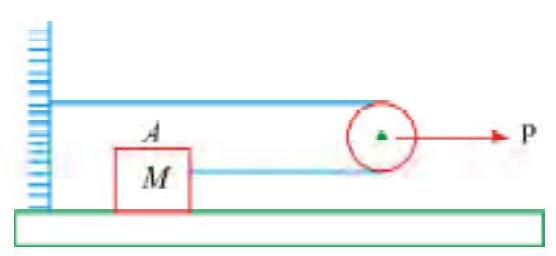270250
Consider three blocks of masses \(m_{1}, m_{2}, m_{3}\) interconnected by strings which are pulled by a common force \(F\) on a frictionless horizontal table as in the figure. The tension\(T_{1}\) and \(T_{2}\) are also indicated

a) \(T_{2}\lt T_{1}\) if \(m_{2}\lt m_{1}\)
b) \(T_{2}=T_{1}\) if \(m_{2}=m_{1}\)
c) \(T_{2}\lt T_{1}\) always
d) acceleration of the system \(=\frac{F}{m_{1}+m_{2}+m_{3}}\)
270253 Two identical blocks each of mass" \(M\) " are tied to the ends of a string and the string is laid over a smooth fixed pulley. Initially the masses are held at rest at the same level. What fraction of mass must be removed from one block and added to the other, so that it has an acceleration of \(1 / 5^{\text {th }}\) of the acceleration due to gravity
270250
Consider three blocks of masses \(m_{1}, m_{2}, m_{3}\) interconnected by strings which are pulled by a common force \(F\) on a frictionless horizontal table as in the figure. The tension\(T_{1}\) and \(T_{2}\) are also indicated

a) \(T_{2}\lt T_{1}\) if \(m_{2}\lt m_{1}\)
b) \(T_{2}=T_{1}\) if \(m_{2}=m_{1}\)
c) \(T_{2}\lt T_{1}\) always
d) acceleration of the system \(=\frac{F}{m_{1}+m_{2}+m_{3}}\)
270253 Two identical blocks each of mass" \(M\) " are tied to the ends of a string and the string is laid over a smooth fixed pulley. Initially the masses are held at rest at the same level. What fraction of mass must be removed from one block and added to the other, so that it has an acceleration of \(1 / 5^{\text {th }}\) of the acceleration due to gravity
270250
Consider three blocks of masses \(m_{1}, m_{2}, m_{3}\) interconnected by strings which are pulled by a common force \(F\) on a frictionless horizontal table as in the figure. The tension\(T_{1}\) and \(T_{2}\) are also indicated

a) \(T_{2}\lt T_{1}\) if \(m_{2}\lt m_{1}\)
b) \(T_{2}=T_{1}\) if \(m_{2}=m_{1}\)
c) \(T_{2}\lt T_{1}\) always
d) acceleration of the system \(=\frac{F}{m_{1}+m_{2}+m_{3}}\)
270253 Two identical blocks each of mass" \(M\) " are tied to the ends of a string and the string is laid over a smooth fixed pulley. Initially the masses are held at rest at the same level. What fraction of mass must be removed from one block and added to the other, so that it has an acceleration of \(1 / 5^{\text {th }}\) of the acceleration due to gravity
270250
Consider three blocks of masses \(m_{1}, m_{2}, m_{3}\) interconnected by strings which are pulled by a common force \(F\) on a frictionless horizontal table as in the figure. The tension\(T_{1}\) and \(T_{2}\) are also indicated

a) \(T_{2}\lt T_{1}\) if \(m_{2}\lt m_{1}\)
b) \(T_{2}=T_{1}\) if \(m_{2}=m_{1}\)
c) \(T_{2}\lt T_{1}\) always
d) acceleration of the system \(=\frac{F}{m_{1}+m_{2}+m_{3}}\)
270253 Two identical blocks each of mass" \(M\) " are tied to the ends of a string and the string is laid over a smooth fixed pulley. Initially the masses are held at rest at the same level. What fraction of mass must be removed from one block and added to the other, so that it has an acceleration of \(1 / 5^{\text {th }}\) of the acceleration due to gravity

